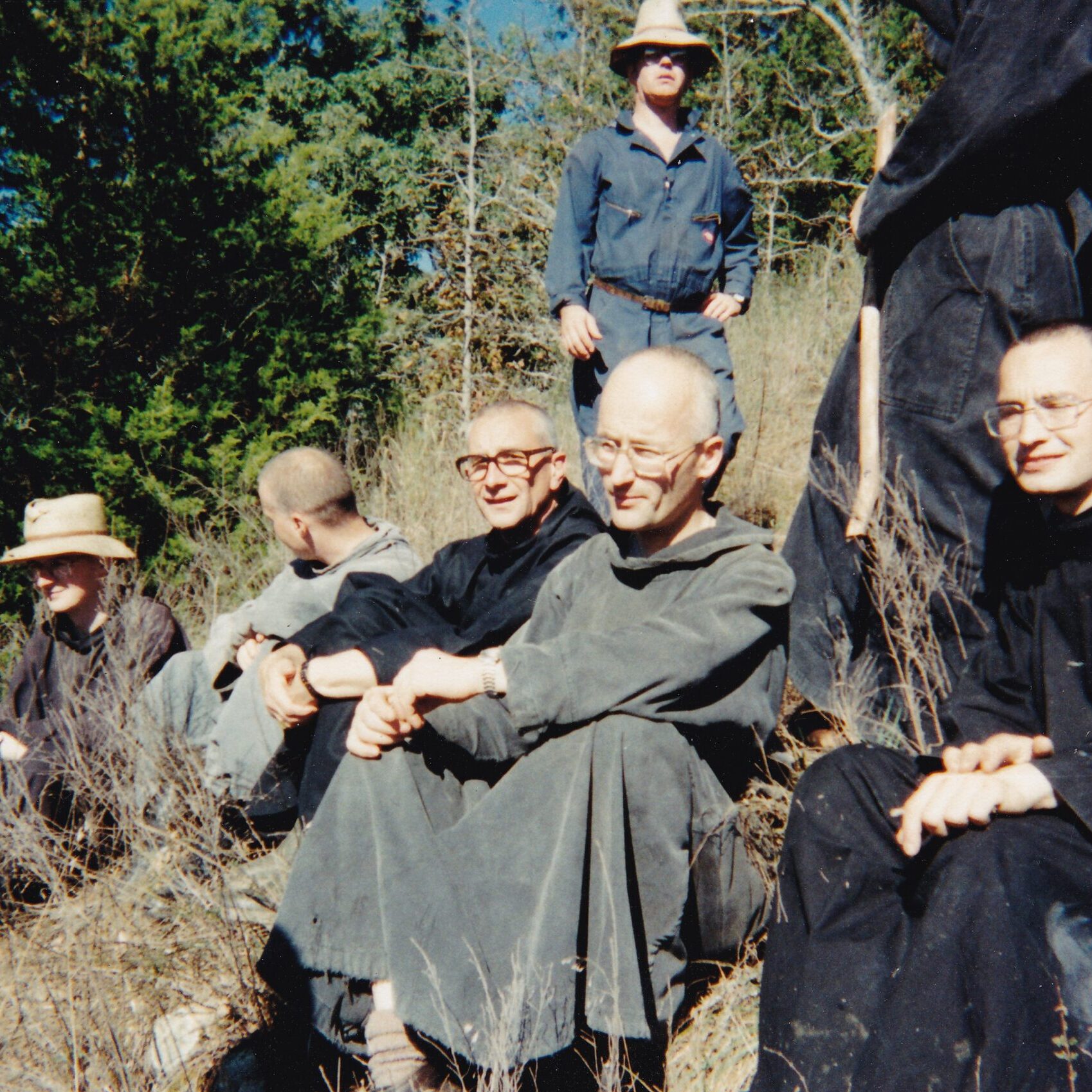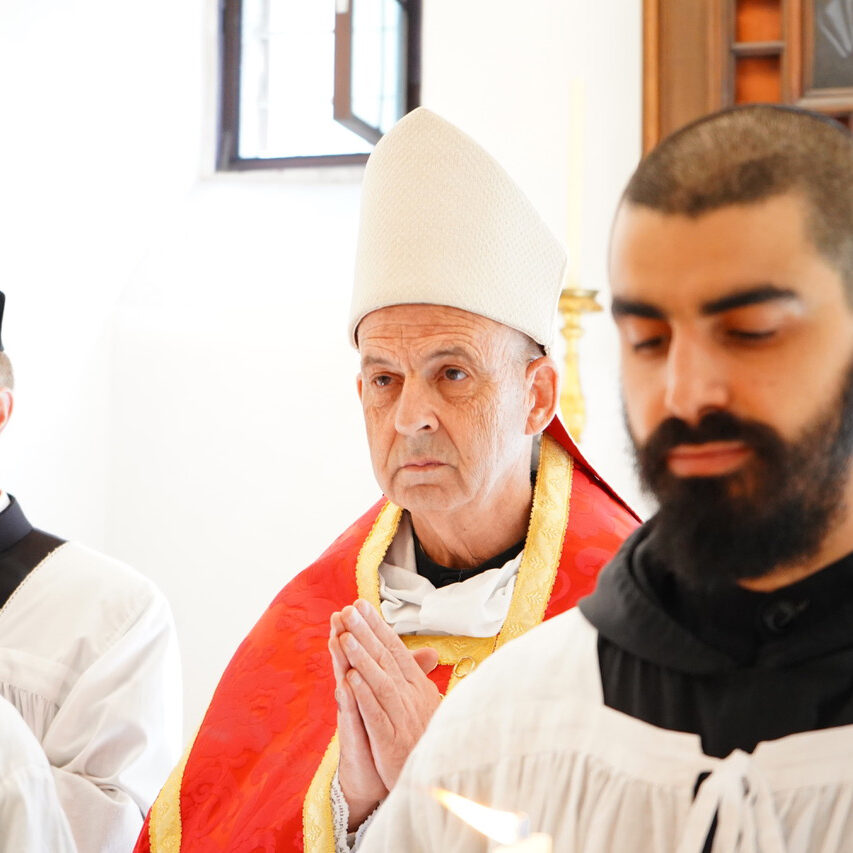Dear Friend of Clear Creek Abbey,
Saint Bernard of Clairvaux is quoted as saying, “You will find something more in woods than in books. Trees and stones will teach you that which you can never learn from masters.” Our monastic life at Clear Creek often takes us into that school of God’s wisdom where we find “tongues in trees, books in the running brooks, sermons in stones, and good in everything” (William Shakespeare, As You Like It, II.i. 1-17). Here is a text summarizing what one of our monks has learned. — br. Philip Anderson, abbot
The inspired and wonderful yet often under-appreciated book of Ecclesiasticus (aka Sirach) tells us: “The principal things necessary for the life of men are water, fire and iron, salt, milk, and bread of flour, and honey,  and the cluster of the grape, and oil, and clothing” (39:31). A good list—and it all begins with water, even supernaturally, for our life in Christ begins with regeneration at the Baptismal font. Water, any natural water, can instrumentally serve for the Sacrament of Baptism, and would thus seem to be entitled to a certain respect. Baptism is the initiation, the doorway to the other Sacraments. Just as the apostles are told to follow the man with the water jar who will lead them to the Upper Room and the Last Supper and the Eucharist (cf. Luke 22:10 ff.), so the water and fire of the Holy Spirit lead to the bread of flour… and the cluster of the grape, all the way to the final anointing with the oil of the Last Rites and the ultimate clothing of the new man with the robe of the elect (cf. 2 Cor. 5:2-4; Gal. 3:27; Eph. 4:24; Col. 3:9; Apoc. 3:5).
and the cluster of the grape, and oil, and clothing” (39:31). A good list—and it all begins with water, even supernaturally, for our life in Christ begins with regeneration at the Baptismal font. Water, any natural water, can instrumentally serve for the Sacrament of Baptism, and would thus seem to be entitled to a certain respect. Baptism is the initiation, the doorway to the other Sacraments. Just as the apostles are told to follow the man with the water jar who will lead them to the Upper Room and the Last Supper and the Eucharist (cf. Luke 22:10 ff.), so the water and fire of the Holy Spirit lead to the bread of flour… and the cluster of the grape, all the way to the final anointing with the oil of the Last Rites and the ultimate clothing of the new man with the robe of the elect (cf. 2 Cor. 5:2-4; Gal. 3:27; Eph. 4:24; Col. 3:9; Apoc. 3:5).
Water is where it all starts when trying to grow plants, too—plants which allow for rotational grazing. Even in Eden it is said that there were not yet any plants of the earth or herbs of the field which had sprung up—“for the Lord God had not rained upon the earth” (Gen. 2:5). Plants need water, even in paradise. This remains true even in the very-much-post-Edenic climate of Oklahoma. Water is usually the single most overlooked plant nutrient, but one has a special sense of it here: in drought and in flood, when the creek is dry or when it is overfull, trying to capture and harness rainfall events, moving water gently so as to prevent soil erosion, growing grass for the dairy cows, keeping the water troughs full for the sheep, hydrating the fruit and nut trees on the permaculture swales in July. And so it struck a deep chord when a benefactor recently donate a solar-powered water pump, with the flexible black plastic pipe to direct the flow. Whoa. Water, fire (of the sun, our solar system’s source of fire), and iron. And did I mention that this pump is portable? Suddenly, a number of interesting possibilities for small-scale, regenerative, low-overhead agriculture open up; iron, powered by fire, pushing water. Can we now put cattle to graze in drier, higher fields which previously lacked a source of water? Yes, and all we need is a big Rubbermaid bucket as a trough. Can we subdivide pastures (using highly-portable electric fence) into smaller units, so as to give the grassy subdivisions a longer rest period for photosynthetic regrowth before animals revisit them? Yes. Can we coordinate the variously-situated pastures into a more symbiotic whole? Yes, that too. Are we better situated to choreograph this “dance”, this dance of pastured chickens and beef cattle and grass and sheep and chestnuts and bees (yes, bees need water to make their honey) with electric polywire fencing and buffalo (okay, that part is made up—we don’t have any buffalo at Clear Creek) and dairy cows which give milk?
 Yes, water drives life. But lest we become too bubbly about the transparent and serviceable side of water, we need to glance back at the abbey’s coat of arms. On it there are two small streams, symbolizing the two creeks which flow through the property: Clear Creek and Little Clear Creek. However, there is also an anchor, the ancient symbol of the anchor-cross. For water is not always a gentle and pacific element. Yes, it can rain hard here; yes, there re floods. Sister Water is very useful and humble and lovely and chaste, st as St. Francis of Assisi says she is; yet she can also be dark and threatening: the downpour, the tempest, the whirlpool, the abyss; and the Psalmist to be delivered from the torrent of evil which is likened to many waters (cf. Ps. 123:4-5). The anchor, with the temper and surety of iron, is the instrument needed when the waters have come up to the soul, in the mire of the deep, in the depth where there is no sure standing (cf. Ps. 68:1-3). Before its healing, cleansing and life-giving potencies can be unleashed, water needs to be purified of its inherent ambiguities. As Romano Guardini aptly points out in his small but powerful book, Sacred Signs, the blessing of holy water is preceded by the exorcism of the water. (And the same is true of the salt used in holy water.) And while the ultimate anchor is theological hope in the cross of Christ, there are also tiny natural anchors, tiny forms of taming water which we use in managing the land here. One of these is pond-building (in imitation of “Brother Beaver”), harnessing the great flows, slowing them down, causing water to soak slowly into the landscape, filtering down through bedrock, recharging springs, restoring the hydrology cycle. Some studies have suggested that before the fur trade largely wiped out the beaver, up to eight percent of the U.S. was covered by beaver ponds. Now that would be a drought-proof landscape. Small ponds, swales, and sponge-like soils high in organic matter: all these combine to form a kind of “surge protection” in the face of large rain events. We also try to keep the ground covered as much as possible: the velocity of rain is lessened if it first strikes vegetation and then drips gently down on to the soil, and this is a help in preventing soil erosion—trees and grasses acting like armor for the earth beneath.
Yes, water drives life. But lest we become too bubbly about the transparent and serviceable side of water, we need to glance back at the abbey’s coat of arms. On it there are two small streams, symbolizing the two creeks which flow through the property: Clear Creek and Little Clear Creek. However, there is also an anchor, the ancient symbol of the anchor-cross. For water is not always a gentle and pacific element. Yes, it can rain hard here; yes, there re floods. Sister Water is very useful and humble and lovely and chaste, st as St. Francis of Assisi says she is; yet she can also be dark and threatening: the downpour, the tempest, the whirlpool, the abyss; and the Psalmist to be delivered from the torrent of evil which is likened to many waters (cf. Ps. 123:4-5). The anchor, with the temper and surety of iron, is the instrument needed when the waters have come up to the soul, in the mire of the deep, in the depth where there is no sure standing (cf. Ps. 68:1-3). Before its healing, cleansing and life-giving potencies can be unleashed, water needs to be purified of its inherent ambiguities. As Romano Guardini aptly points out in his small but powerful book, Sacred Signs, the blessing of holy water is preceded by the exorcism of the water. (And the same is true of the salt used in holy water.) And while the ultimate anchor is theological hope in the cross of Christ, there are also tiny natural anchors, tiny forms of taming water which we use in managing the land here. One of these is pond-building (in imitation of “Brother Beaver”), harnessing the great flows, slowing them down, causing water to soak slowly into the landscape, filtering down through bedrock, recharging springs, restoring the hydrology cycle. Some studies have suggested that before the fur trade largely wiped out the beaver, up to eight percent of the U.S. was covered by beaver ponds. Now that would be a drought-proof landscape. Small ponds, swales, and sponge-like soils high in organic matter: all these combine to form a kind of “surge protection” in the face of large rain events. We also try to keep the ground covered as much as possible: the velocity of rain is lessened if it first strikes vegetation and then drips gently down on to the soil, and this is a help in preventing soil erosion—trees and grasses acting like armor for the earth beneath.
Drawing on various ideas from a variety of sources, the monks are trying to use the gift of water (and other gifts) in a constructive way, working with God, with nature, with some good ideas from friends and books, with a bit of technology and with boots-on-the-ground, towards a harmonious balance on the land. Though sometimes the “waters roared and were troubled”, yet “the stream of the river maketh the city of God joyful…” (Ps. 45:4-5).
– A Monk of Clear Creek






